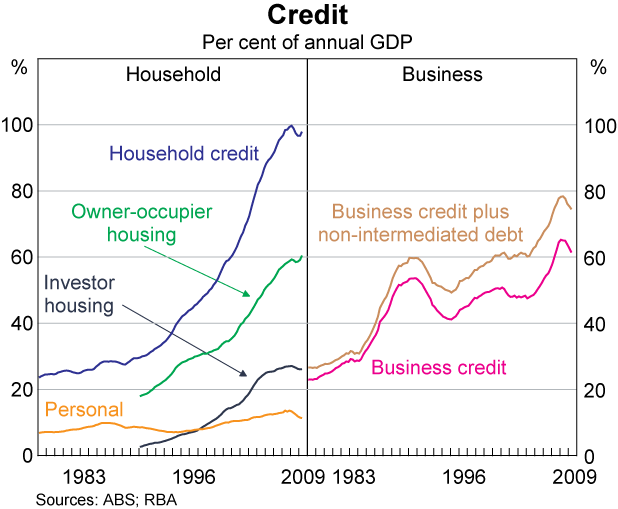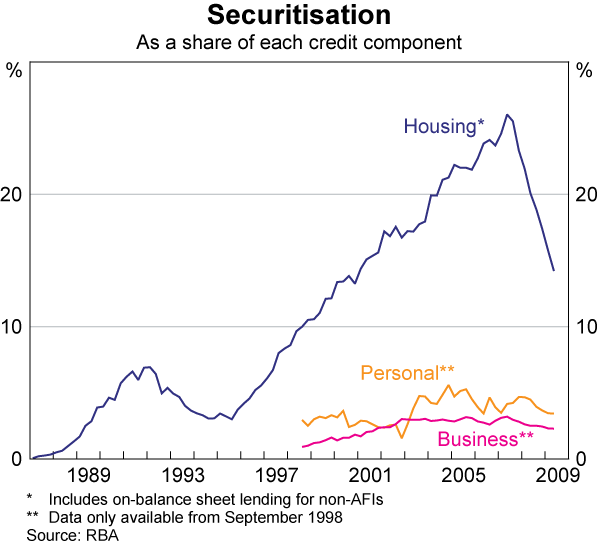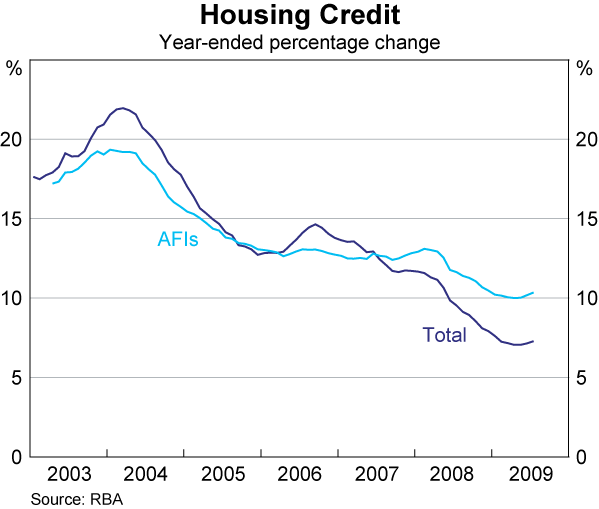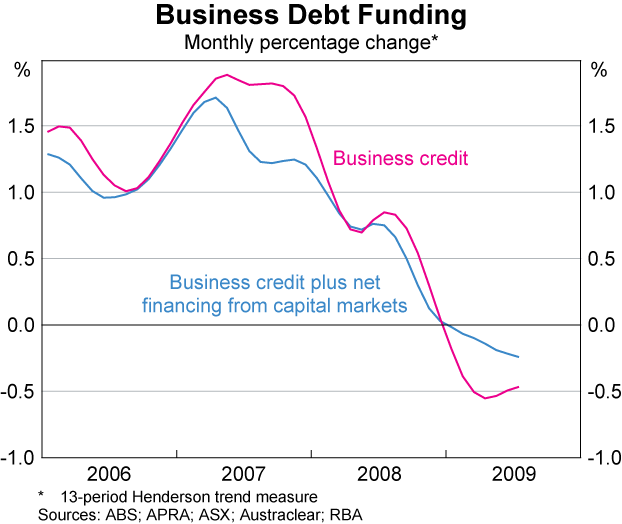Bulletin – September 2009 Measuring Credit[1]
- Download 164KB
Introduction
Central banks put significant emphasis on credit aggregates for understanding financial conditions in the economy. Measuring credit outstanding, however, is not straightforward, particularly in a financial system that is experiencing ongoing structural change. Given this, the Reserve Bank – which constructs the credit aggregates for Australia – has made considerable efforts over recent years to ensure that the credit measures remain up to date and evolve with the Australian financial system, as well as to measure corporate non-intermediated borrowing. This article discusses the Bank's current approach to measuring credit and non-intermediated debt flows.
What Is Credit?
Credit represents debt funding provided by domestic financial intermediaries to the domestic private non-financial sector in the form of loans and securities.[2] In Australia, credit has historically included lending by ‘all financial institutions’ (AFIs), which includes banks, other authorised deposit-taking institutions (building societies and credit unions) and registered financial corporations (money market corporations, finance companies and general financiers). However, as discussed below, the growth of securitisation as a means of funding lending and the associated rise of non-traditional lenders over the past decade have required that the definition of credit be adjusted, with additional data collected to include a broader set of financial entities. The approach taken by the Bank has been to include securitised assets in the headline credit measures and also to publish a measure of narrow credit which excludes securitised assets. In addition, the Bank constructs measures of corporate non-intermediated debt outstanding – which are published separately and not included in the measures of credit – in order to monitor growth in total business debt in a timely fashion.
The RBA publishes monthly credit data approximately four weeks after the end of the reference month.[3] The level of credit was $1.9 trillion (159 per cent of GDP) in the June quarter 2009 (Table 1 and Graph 1). By type of lender, banks accounted for 87 per cent of credit, registered financial corporations, building societies and credit unions together accounted for another 9 per cent, and the remaining 4 per cent was accounted for by other entities (including cash management trusts, specialist credit card institutions and mortgage originators). While only constituting a small share of total credit, lending by these ‘other’ institutions has been volatile, having fallen by around one-third over the past couple of years, after rising significantly over the preceding few years.
| Level | Share of credit | Growth | ||
|---|---|---|---|---|
| $b | Per cent | Year-ended, per cent | ||
|
June quarter 2009 |
June quarter 2008 |
June quarter 2009 |
||
| By institution type | ||||
| Banks | 1,665 | 87 | 14 | 6 |
| – Major | 1,342 | 70 | 14 | 8 |
| – Other | 323 | 17 | 15 | −4 |
| Registered financial corporations | 111 | 6 | 6 | −5 |
| Building societies & credit unions | 64 | 3 | 8 | 3 |
| Other | 74 | 4 | −8 | −26 |
| By borrower type | ||||
| Household | 1,176 | 61 | 9 | 5 |
| – Housing | 1,039 | 54 | 10 | 7 |
| – Owner-occupier | 725 | 38 | 10 | 9 |
| – Investor | 314 | 16 | 8 | 3 |
| – Personal | 136 | 7 | 3 | −7 |
| Business | 738 | 39 | 17 | 0 |
| Total | 1,914 | 100 | 12 | 3 |
| Memo: | ||||
| Non-intermediated debt | 157 | 8 | −1 | 4 |
|
Source: RBA |
||||

By borrower type, households accounted for 61 per cent of the stock of credit in the June quarter 2009, up significantly from 36 per cent in 1989. Housing credit accounts for around 88 per cent of household credit, and personal credit (which includes credit cards, margin loans and other loans) accounts for the remainder. The other part of aggregate credit – which accounted for 39 per cent of the total in the June quarter – is lending to businesses. Non-intermediated funding, including corporate bonds, is not included in the credit aggregates and was equivalent to 8 per cent of the value of credit in the June quarter 2009.
How Credit Is Measured
International statistical standards, such as the IMF Monetary and Financial Statistics Manual or the System of National Accounts 1993 (SNA93), provide only limited guidance about measuring credit and encourage compilers to ‘develop measures that are analytically useful in their specific institutional settings’.[4] From the Bank's perspective, the key purpose of the credit measures is to accurately measure the level and growth of household and business sector borrowing from intermediaries, as part of its overall assessment of financial conditions and the economy more generally.
The majority of the data used to construct credit is collected by the Australian Prudential Regulation Authority (APRA) under powers set out in the Banking Act 1959 and the Financial Sector (Collection of Data) Act 2001.[5] By the 10th business day of each month, banks, building societies, credit unions and registered financial corporations are required to submit to APRA a snapshot of their balance sheet as at the end of the previous month. To calculate credit there are around 40 item codes in three reporting forms for around 60 reporting banks, while for building societies, credit unions and registered financial corporations there are around 22 item codes for around 280 institutions.
The data received go through an intensive checking process which involves the Bank, APRA and the financial institutions. Each month, as part of the quality control process, the Bank sends a significant number of queries to the financial institutions, via APRA, regarding unusual movements in the data. Explanations for these movements, or revisions to the data, are typically received within five working days and are often used to make adjustments to the credit numbers, discussed further below. In addition, the Bank augments the APRA data with information from outside the usual reporting regime, including data collected directly from non-traditional lenders and by the ABS. Reviews of the reporting forms and systems used to collect data are conducted periodically, with the most recent review taking place in 2005.
Adjusting for series breaks and seasonality
In calculating the financial aggregates the Bank is not only seeking to measure the aggregate level of credit but also the underlying pace of growth in credit, abstracting from movements in financial institutions’ balance sheets due to changes in the structure of the banking system (such as mergers and the establishment of new banks) and changes in the way the data are reported (such as the transfer of assets between financial entities or reclassifications of assets within an institution). While published credit levels are not break-adjusted, and purely reflect the data as reported by the financial institutions, published growth rates are all break-adjusted, with the breaks reported in the technical notes to tables in the RBA Bulletin. The Bank also seasonally adjusts credit. In 2006 the Bank moved to concurrent seasonal adjustment of the credit data, with seasonal factors re-estimated using the X-12-ARIMA Seasonal Adjustment Program each month with the release of new data. Previously, seasonal factors were re-estimated annually by the ABS.
Securitisation and non-traditional lenders
The growth of non-traditional lenders and new funding sources – in particular, the increase in off-balance sheet lending through institutions with a trust structure (for example, conduits, warehouses, special purpose vehicles) – has raised two important issues for the measurement of credit: how to deal with lending conducted by new types of institutions that fall outside the scope of the traditional reporting forms; and how to deal with lending that is conducted by traditional lenders but then moves from their balance sheets to those of non-traditional entities.
Prior to April 2004, the Bank's approach was to estimate the stock of credit from the balance sheets of reporting financial intermediaries, and then make adjustments to growth rates for securitisations by these institutions where an associated decline in their balance sheets was identified. While this approach was satisfactory when there was little securitisation, it had become increasingly problematic over time. This was a greater issue for housing lending than business lending, since securitisation accounts for a larger share of housing credit than other types of credit, and it had also become more significant over time as off-balance sheet lending grew throughout the 1990s and early 2000s (Graph 2).

In response to these concerns the Bank expanded the scope of the credit data in mid 2004. New APRA forms, which separately identified loans originated by banks, building societies and credit unions that were no longer on their balance sheets, allowed the Bank to more effectively incorporate securitised loans from these institutions into the credit aggregates. Coverage was extended to registered financial corporations in mid 2006.
Incorporating loans originated by non-traditional lenders has presented more challenges, since these institutions are not required to report in the same way as AFIs. Initially, the Bank estimated the lending of the non-AFI sector using quarterly securitisation data from the ABS and from market sources, augmented with loan approvals data for the most recent months. While this method had the benefit of being comprehensive, there was often a lag between the origination of the loan and the sale of the security that funded the loan, which introduced noise into the measures of credit growth. This method also led to noticeable revisions from time to time, reflecting differences between the estimates constructed using loan approvals data and the securitisation data. To overcome this problem, since 2007 the Bank has collected lending data, on a voluntary basis, from most of the non-AFIs.[6] The broader measures of credit now include all identified lending to the private non-financial sector by intermediaries, irrespective of whether the loan is originated by an AFI or a non-traditional lender and whether it remains on the balance sheet of the lending institution or is securitised and on-sold to the non-financial sector.[7]
The importance of fully capturing securitised lending has been apparent over the past two years, with the global financial crisis particularly affecting non-traditional lenders that relied almost entirely on securitisation markets. The market share of these lenders has fallen significantly, with banks gaining market share. As a result, measures of housing credit that only focus on lending by the traditional AFI sector are somewhat stronger than measures of overall housing credit growth; the reverse was true in the earlier years of this decade (Graph 3).

Non-intermediated debt
While business credit is an important component of total business debt, businesses also borrow directly from capital markets by issuing bonds, promissory notes and hybrid securities. To obtain a more comprehensive picture of corporate debt levels, the Bank supplements the credit aggregates with a measure of non-intermediated debt which is constructed using a variety of market sources and by monitoring domestic financial markets for information on amounts, scheduled maturity, pricing and other relevant terms of debt issues (Graph 4).[8] On occasion this measure of debt can behave quite differently to business credit. For example, during late 2007, when capital markets were under severe stress, there was a period of re-intermediation as companies turned to banks instead of raising debt directly from capital markets, which boosted narrow business credit growth estimates (Graph 5). More recently, weakness in business credit has been somewhat offset by increased funding using bonds and notes, with broader measures of business debt stronger than the narrower business credit measure.


Footnotes
This article was prepared by Laura Berger-Thomson and Paul Bloxham of Economic Group. [1]
Lending to the government sector is also measured and separately reported. [2]
The most recent data can be accessed on the internet at
<http://www.rba.gov.au/statistics/frequency/fin-agg/2009/>.
[3]
As pointed out in the IMF's Monetary and Financial Statistics Manual, published in October 2000, ‘… there are no unique definitions of credit and debt, and the 1993 SNA does not define such measures’ (p 66). It further suggests that ‘[t]he composition and coverage of credit measures should be reviewed periodically to ensure that they reflect the changing use of credit instruments and new credit channels, such as greater reliance on securities markets at the expense of financial intermediation, and changes in the types of financial assets used in the provision of credit’. [4]
Data collected under the Financial Sector (Collection of Data) Act 2001 were previously collected by the Bank under the Financial Corporations Act 1974. Neither act includes provisions for the collection of data from entities with a trust structure, which covers the majority of vehicles used by specialist mortgage lenders to fund their loans. [5]
The Bank currently receives monthly data from lenders accounting for around 80 per cent of this market, and estimates the securitised lending of institutions outside of this reporting. [6]
Reduced opportunities to securitise housing loans since the beginning of the global financial crisis have also prompted securitisation vehicles (trusts, conduits, etc) to rely on lines of credit with banks and other AFIs, and AFIs have been reporting such lending as credit to the business sector. Given that this lending is also captured in household credit, it would be double-counting to include it in business lending, so since August 2007 AFIs have separately identified any such lending through the query process, which has facilitated appropriate adjustment of the business credit estimates. [7]
This measure includes debt issued in foreign markets by domestic corporations but excludes cross-border lending by domestic financial institutions, which is only a small component. Measures of equity funding are also available and monitored by the Bank. [8]